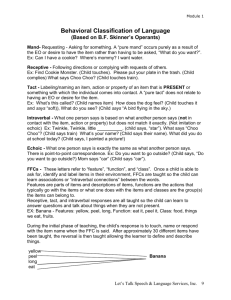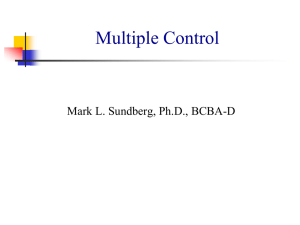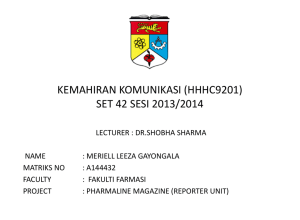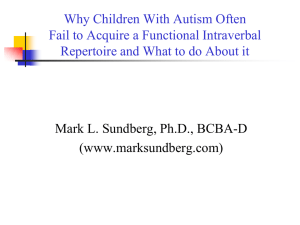What is Intraverbal Behavior?
advertisement
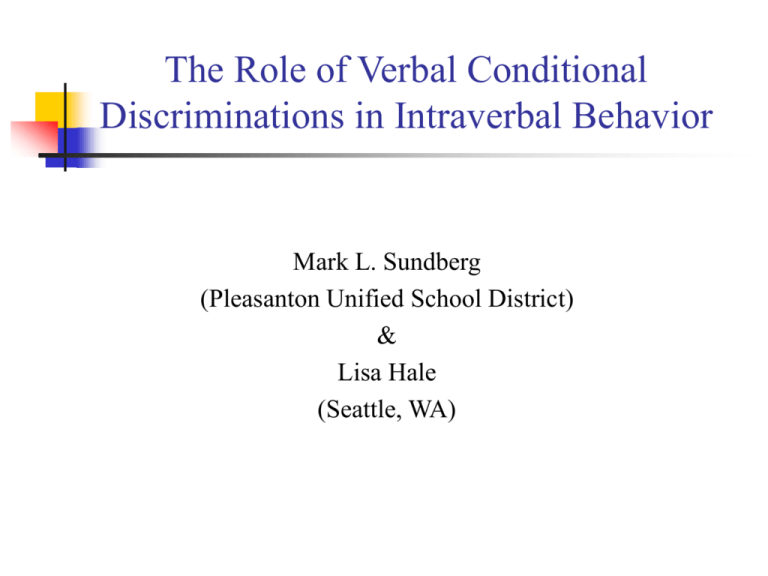
The Role of Verbal Conditional Discriminations in Intraverbal Behavior Mark L. Sundberg (Pleasanton Unified School District) & Lisa Hale (Seattle, WA) Conditional Discriminations • • Conditional discrimination: “A discrimination in which reinforcement of responding during a stimulus depends on (is conditional on) other stimuli” (Catania, 1998, p. 382) Conditional discrimination: “When the nature or extent of operant control by a stimulus condition depends on some other stimulus condition” (Michael, 1993, p. 14) Conditional Discriminations Extensive behavioral research on conditional discriminations (CDs) Most of it involves matching-to-sample tasks consisting of nonverbal CDs (e.g., Saunders & Spradlin, 1989) Some of it involves verbal stimuli and nonverbal response (receptive discriminations) (e.g., Kelly, Green, & Sidman, 1998) However, there is very little behavioral research on verbal conditional discriminations and verbal responses (intraverbal behavior) Catania (1998) provides some conceptual direction with his analysis of how a verbal context alters the evocative effect of other verbal stimuli via conditional discriminations Verbal Conditional D Discriminations (VC ) • • • • • What constitutes a verbal conditional discrimination and an intraverbal response? Two components of a verbal stimulus where one verbal stimulus alters the evocative effect of the second verbal stimulus, and collectively they evoke a differential intraverbal response Skinner (1957) calls this a “compound verbal stimulus,” but does not use the term “conditional discrimination” or its definition Antecedent Response Verbal SD1 + Verbal SD2 Intraverbal Response Verbal Conditional D Discriminations (VC ) • Examples... Antecedent Verbal SD1 + Verbal SD2 Define a mand Exemplify a mand Define a tact Exemplify a tact • VCD=VSD1 alters the evocative effect of VSD2 or vice versa • • • • • • Intraverbal Response A type of verbal behavior... Saying “car” as a function... A type of verbal behavior... Saying “car” as a function... Verbal Conditional D Discriminations (VC ) • • • • • • • • • • More complex examples... Antecedent Intraverbal Response VSD1 + VSD2 + VSD3 Define a disguised mand Define a magical mand Define a self-mand Define an autoclitic mand A response controlled by... A mand that cannot be... A mand where the speaker... A type of secondary verbal... VSD1 + VSD2 + VSD3 + VSD4 Define a manipulative autoclitic mand Exemplify a quantitative autoclitic tact A type of secondary... A type of secondary… Teaching Intraverbal Behavior to Children with Autism • • • • • • • • Children with autism have a difficult time acquiring intraverbal behavior Beyond simple intraverbals (“A kitty says...”), most intraverbal responses are controlled by VCDs. For example... “Name a food” “Name a hot food” ‘Name a breakfast food” “Name a sweet food” “What did you do today at school?” Current Study • • • • • • • Is there a general sequence of increasingly complex VCDs that can be used for intraverbal assessment and intervention? When are typically developing children successful at these discriminations? 51 typical children and 18 children with autism served as participants Ages ranged from 17 months old to 10 1/2 years old Two 80-question intraverbal assessments were designed with increasingly complex verbal discriminative stimuli and VCDs The first assessment presented a wide range of IV tasks, while the second assessment specifically focused on a variety of VCDs Parents and classroom staff administered the assessment Intraverbal Assessment: Level 7: Multiple SDs with Prepositions, Adverbs, & Negation Verbal S D What do you eat with? What animal moves slow? Tell me something that is not a food What do you write on? Where do you talk quietly? What is something you can't wear? What do you sit at? What is between the blankets and the bed? What animal goes fast? What's something that is not a musical instrument? Score Response Examples of the Types D of VC s Assessed • • • • • • • • • • WH questions (e.g., What vs, Who vs. When, etc.) Noun-noun (e.g., Friday, Saturday...vs. Sunday, Saturday...) Noun-verb (e.g., animal that flies...vs. vehicle that flies...) Verb-preposition (e.g., you write with... vs. you write on...) Preposition-noun (e.g., under a house vs. above a house) Adjective-noun (e.g., big animal vs. little animal) Adverb-noun (e.g., fast animal vs. slow animal) Multiple component CVDs (e.g., What goes on a race track and has wheels? vs. ...has legs) Negation (e.g., Something that is not a musical instrument) Time concepts (e.g., What day come before Wednesday? vs. ...after Wednesday) Typical Children Age and Scores on the IV Assessment T ypical Children Intraverbal Assessment Scores 80 IV Score Age in Months and Intraverbal Score 70 60 50 40 Age in Months 30 20 10 0 0 1 2 3 4 5 6 7 8 9 10 11 12 13 14 15 16 17 18 19 20 21 22 23 24 25 26 27 28 Children Error Analysis of the Typical Children’s Intraverbal Behavior and VCDs • • • • • 1 ½ year olds Generally no IV behavior 2 year olds Minimal intraverbal behavior, no VCDs Some song fill-ins; lots of echoic; no WH answers (except name) Error Analysis of the Typical Children’s Intraverbal Behavior and VCDs • • • • • 2 1/2 year olds Some simple intraverbal behavior, minimal VCDs Frequent echoic responding (e.g., Knife fork and... evoked Fork and; What can you wear? evoked What can you wear) When some intraverbal control was demonstrated, often simple IV relation, no conditional discriminations, the last, or prominent word was the source of stimulus control (e.g., A dog, cat and monkey are all... evoked Jumping on the bed) Rote responses were evident. What day is today? ... Rainy (when it was sunny) Error Analysis of Typical Children’s Intraverbal Behavior and VCDs • • • • • • • • 3-year olds Well established basic intraverbal repertoire, 100s of IV relations But verbal conditional discrimination errors were prevalent (e.g., What do you smell with? evoked Poopies; What do you find on a playground? evoked Outside) Most “WH” questions causes problems (e.g., When do you sleep? evoked In a big girl bed) Problems with verbs, prepositions, adjectives, adverbs in VCDs (e.g., What grows on a tree? evoked birds; you write on... evoked Crayons) Unable to respond to negation, time, personal information (beyond first name e.g., What is your last name? evoked Katie) Two causes of errors: VCDs & complexity of each word (e.g., most 3 year old children did not know what a “vehicle” was, or were able to tact “last”) Error Analysis of Typical Children’s Intraverbal Behavior and VCDs • • • • • • • 3 1/2 year olds Still emitted echoic responses when no intraverbal occurred Verbal conditional discrimination errors were very common with harder words (e.g., What animal moves slow? evoked fast) Negation in a VCD was major problem: What can’t you wear? evoked jacket Still having problems with verbs, prepositions, adjectives, adverbs in VCDs (e.g., What do you smell with? evoked Pizza) Problems with multiple component VCDs (e.g., Can you tell me a vehicle that flies? evoked Bird) Problems with time concepts (e.g., What meal is before lunch? evoked Bananas) Error Analysis of Typical Children’s Intraverbal Behavior and VCDs • • • • • • 4 year olds Verbal conditional discrimination errors were still common, (e.g., When do you eat dinner? evoked At the table; Where do you go to school? evoked Play) But VCDs are clearly getting stronger (e.g., Who takes you to school? evoked Nobody, but I need my backpack) Problems with VCD intraverbal yes-no questions (e.g., Is a banana a fruit? evoked Yes and Is a banana a vegetable? evoked Yes) “Not” continued to be a problem for most kids (e.g., Tell me something that is not a musical instrument evoked Drum) Other problems include time concepts, WH questions, multiple component VCDs (e.g., What goes on a race track and has wheels? evoked Train) Error Analysis of Typical Children’s Intraverbal Behavior and VCDs • • • • • • 5 year olds Much better at VCDs. Some 5 year olds had near perfect scores However, they still problems with WH questions (Who takes you to school? evoked bus) Before and after, time concepts (What day is before Wednesday? evoked Thursday) Almost everybody missed What day is today? including the five year olds The words different, can’t, & not as verbal stimuli produced errors for many kids. Funny Intraverbal Responses: “Kids say the darnedest things” • • • • • • “What can you kick?” ... “We only kick balls” “What do you write on?” ... “We only write on paper” “What day is it? ... “Football day (Sunday)” “What do you do with soap” ... “In my mouth” “What’s in the kitchen?” ... “Lot’s of junk” “Where do you sit” ... “In the time-out chair” Intraverbal and VCD Assessment Results for Children with Autism • • • • 18 children served as participants Most were from PUSD Ages ranged from 37 months old to 10 1/2 years old. Classroom staff administered the assessment Children with Autism Age and Scores on the Intraverbal Assessment Children with Autism Intraverbal Assessment Scores 13 0 12 0 Age in Months and Intraverbal Score 11 0 Age in Months 10 0 90 80 70 60 IV Score 50 40 30 20 10 0 0 1 2 3 4 5 6 Children 7 8 9 10 11 12 Typical Children Age and Scores on the Intraverbal Assessment T ypical Children Intraverbal Assessment Scores 80 IV Score Age in Months and Intraverbal Score 70 60 50 40 Age in Months 30 20 10 0 0 1 2 3 4 5 6 7 8 9 10 11 12 13 14 15 16 17 18 19 20 21 22 23 24 25 26 27 28 Children Error Analysis of the Children with Autism’s Intraverbal Behavior • • • • • The children with autism made the same types of errors as typical children who scored at their level Verbal conditional discriminations were hard for all children especially those involving “WH” questions (e.g., Where do you bake cookies? evoked Mommy; What do you smell in the oven? evoked Flower; Where do you buy food? evoked Apples) Rote responding was more obvious, and more firmly established Echoic responses more frequent Negative behavior higher with increasing complexity of the verbal stimulus Conclusions • • • • • • • Most intraverbal responding involves verbal conditional discriminations Typical language development can serve as an important guide for curriculum development for children with autism A functional analysis of the verbal errors made by typical children with VCDs can help us understand the errors made by children with autism Children with autism had the same problems with VCDs and made the same intraverbal errors as typical children who scored at their level There is very little behavior research on VCDs and their relation to intraverbal behavior VCDs are an excellent, exciting, and greatly needed area for empirical research Existing conditional discrimination research can serve as a guide for VCD research (e.g., Saunders & Spradlin, 1989) Panel Questions • • • • • • What is the difference between: Conditional discrimination Compound stimulus control Multiple control Joint control When was the term “conditional discrimination” first introduced into the behavior vernacular?
